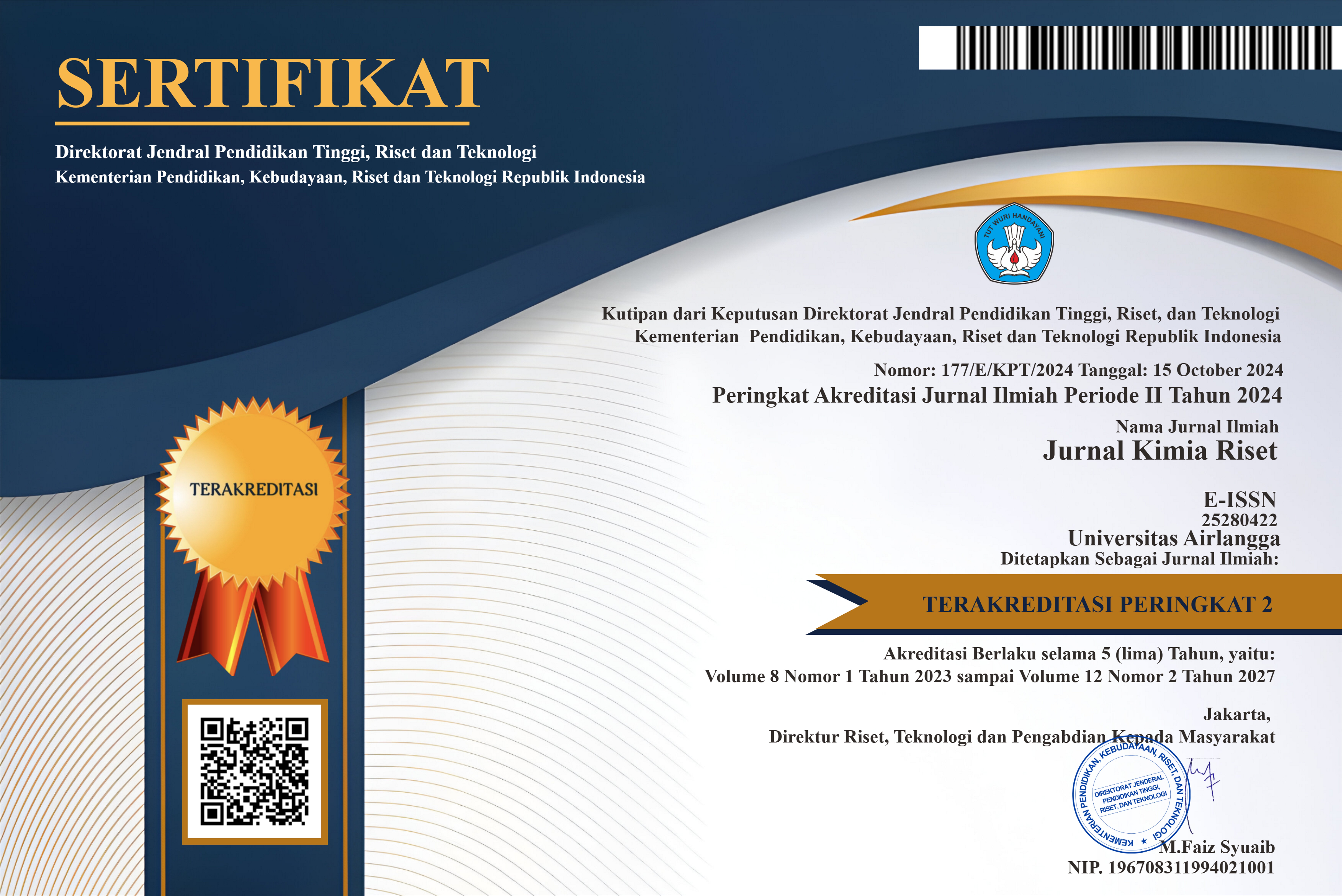DEGRADATION OF HUMIC ACID BY FLOATING PHOTOCATALYST TiO2/Cu-ARECA FIBER
Downloads
The photocatalyst method is effective in degrading humic acid into O2 and H2 compounds
that are more environmentally friendly. The photocatalysis process involves light and
semiconductors such as TiO2 to accelerate the reaction rate. Therefore, modification of TiO2
is needed to shift light absorption to visible light by using Cu2+ doping and areca fiber. XRD
characterization shows that Merck's TiO2 has shifted at 2θ, indicating that Cu has entered
the TiO2 structure, and several peaks have reduced in intensity after being embedded with
areca fiber, indicating that TiO2/Cu has successfully attached to areca fiber. FTIR results
show that TiO2/Cu has been attached to the areca fiber, which is marked by shifting and
weakening the intensity of the Ti-O-Cu wave number absorption. The test results show that
TiO2/Cu embedded in areca fiber had higher degradation activity than TiO2/Cu without
embedded, with a percent degradation of 54% for 180 minutes of irradiation. These results
prove that TiO2/Cu floated to the surface of the solution can optimize irradiation so that it
is effective in the degradation process.
Adnan, F., Hidayat, R.K. and Meicahayanti, I., 2021. Pengaruh pH, UV dan TiO2 untuk mendegradasi variasi asam humat berbasis fotokatalis. Jurnal Teknologi Lingkungan UNMUL, 5(2), 9–16.
Akbar, A.F., 'Aini, F.Q., Nugroho, B. and Cahyaningrum, S.E., 2021. Sintesis dan karakterisasi hidroksiapatit tulang ikan baung (Hemibagrus nemurus sp.) sebagai kandidat implan tulang. Jurnal Kimia Riset, 6(2), 93–101.
Aritonang, A.B., Sapar, A. and Furqonita, A., 2021. Photocatalytic bacterial inactivation using Bi-doped TiO2/kaolinite under visible light irradiation. International Conference on Science and Engineering (ICSE-UIN-SUKA 2021). 105–111.
Ayunda, S.R., Zainul, R., Putra, A. and Oktavia, B., 2022. Degradasi asam humat dengan katalis TiO2/N menggunakan cahaya matahari. Periodic, 11(2), 84–88.
Bakre, P. V. and Tilve, S.G., 2018. Direct access to highly crystalline mesoporous nano TiO2 using sterically bulky organic acid templates. Journal of Physics and Chemistry of Solids, 116, 234–240.
Dalponte, I., de Sousa, B.C., Mathias, A.L. and Jorge, R.M.M., 2019. Formulation and optimization of a novel TiO2/calcium alginate floating photocatalyst. International Journal of Biological Macromolecules, 137, 992–1001.
Darojati, H.A., Ganesha, S.D. and Ariyanti, D., 2022. Pengaruh variasi dosis iradiasi gamma pada pemisahan komponen penyusun biomassa lignoselulosa sabut kelapa. Jurnal Selulosa, 12(1), 23–32.
Dewi, A.M.P., Kusumaningrum, M.Y., Edowai, D.N., Pranoto, Y. and Darmadji, P., 2017. Ekstraksi dan karakterisasi selulosa dari limbah ampas sagu. Prosiding SNST. 6–9.
Ekasari, V. and Yudoyono, G., 2013. Fabrikasi DSSC dengan dye ekstrak jahe merah (Zingiber officinale Linn Var. Rubrum) variasi larutan TiO2 nanopartikel berfase anatase dengan teknik pelapisan spin coating. Jurnal Sains dan Seni POMITS, 2(1), 15–20.
Firmansyah, W.B., Rokhmat, M. and Wibowo, E., 2019. Pelapisan titanium dioksida pada plastik mika sebagai fotokatalis untuk mendegradasi metilen biru. e-Proceeding of Engineering. 1157–1164.
Gao, Y., Qin, J., Wang, Z. and í˜sterhus, S.W., 2019. Backpulsing technology applied in MF and UF processes for membrane fouling mitigation: A review. Journal of Membrane Science, 587(117136), 1–20.
Ghazali, S.S., Jusoh, R. and Shariffuddin, J.H., 2019. Parameter affecting photocatalytic degradation of POME using LaCa as photocatalyst. Materials Today: Proceedings. 1173–1182.
Handayani, R. and Taer, E., 2019. Pengaruh waktu aktivasi terhadap sifat fisis dan elektrokimia sel superkapasitor dari sabut pinang. Komunikasi Fisika Indonesia, 16(2), 87–90.
Hawari, F.Y., Zainul, R., Aini, S. and Nizar, U.K., 2022. Pengaruh pengadukan pada degradasi asam humat menggunakan reaktor mobile heksagonal. Periodic, 11(2), 27–30.
Hou, C., Xie, J., Yang, H., Chen, S. and Liu, H., 2019. Preparation of Cu2O@TiOF2/TiO2 and its photocatalytic degradation of tetracycline hydrochloride wastewater. RSC Advances, 9(65), 37911–37918.
Hu, P., Li, H., Tan, Y., Adeleye, A.S. and Hao, T., 2024. Enhanced electrochemical treatment of humic acids and metal ions in leachate concentrate: experimental and molecular mechanism investigations. Journal of Hazardous Materials, 462(132774).
Kanani, N., Saputro, A.B.A., Puspawati, I. and Pratama, A.A., 2019. Preparasi selulosa dari limbah tongkol jagung dengan bantuan gelombang iradiasi ultrasonik. Inudstrial Research Workshop and National Seminar. 20–27.
Karmuliani, H. and Mahyudin, A., 2020. Karakterisasi sifat mekanik film PVA berserat selulosa kulit buah pinang (Areca catechu L) yang mengalami perlakuan NaOH. Jurnal Fisika Unand, 9(4), 495–501.
Kunarti, E.S., Kartini, I., Syoufian, A. and Widyandari, K.M., 2018. Synthesis and photoactivity of Fe3O4/TiO2-Co as a magnetically separable visible light responsive photocatalyst. Indonesian Journal of Chemistry, 18(3), 403–410.
Lubis, J.K.O., Utomo, K.P. and Sutrisno, H., 2021. Pemanfaatan sabut pinang (Areca catechu L) sebagai adsorben dalam pengolahan air sumur bor. Jurnal Rekayasa Lingkungan Tropis, 2(1), 1–10.
MiarAlipour, S., Friedmann, D., Scott, J. and Amal, R., 2018. TiO2/porous adsorbents: recent advances and novel applications. Journal of Hazardous Materials, 341, 404–423.
Mohtar, S.S., Aziz, F., Nor, A.R.M., Mohammed, A.M., Mhamad, S.A., Jaafar, J., Yusof, N., Salleh, W.N.W. and Ismail, A.F., 2021. Photocatalytic degradation of humic acid using a novel visible-light active α-Fe2O3/NiS2 composite photocatalyst. Journal of Environmental Chemical Engineering, 9(4), 1–12.
Muhammad, Ishak, Azhari, Nurfarida and Darmadi, 2019. Penyerapan zat warna basic red 18 dan direct black 38 dengan menggunakan sabut pinang sebagai adsorben. Jurnal Rekayasa Kimia & Lingkungan, 14(1), 72–80.
Nuhaeroh, I., Anwar, D.I. and Khumaisah, L.L., 2022. Aktivitas antibakteri nanokomposit TiO2/Cu dan TiO2/CuO terhadap bakteri Bacillus cereus. Jurnal Sains Dasar, 11(2), 95–100.
Phromma, S., Wutikhun, T., Kasamechonchung, P., Eksangsri, T. and Sapcharoenkun, C., 2020. Effect of calcination temperature on photocatalytic activity of synthesized TiO2 nanoparticles via wet ball milling sol-gel method. Applied Sciences, 10(993), 1–13.
Qurban, M.A., Wafar, M., Jyothibabu, R. and Manikandan, K.P., 2017. Patterns of Primary Production in the Red Sea. Journal of Marine Systems, 169, 87–98.
Rahayu, A., Juliantri, L. and Amalia, R.Y., 2022. Degradasi remazol yellow FG dengan katalis oksida besi/karbon aktif dengan metode fotokatalis. Jurnal Teknik Kimia, 28(3), 126–132.
Rahman, N.A., Jol, C.J., Linus, A.A., Ming, C.K., Arif, P., Baharuddin, N., Borhan, W.W.S.W., Jalal, N.S.A., Samsul, S.N.A., Mutalip, N.A., Jitai, A.A. and Hamid, D.F.A.A.A., 2023. Treatment of tropical peat water in Sarawak peatlands nature reserve by utilising a batch electrocoagulation system. Sustainable Chemistry for the Environment, 4(100043), 1–10.
Reddy, N.L., Reddy, G.K., Basha, K.M., Mounika, P.K. and Shankar, M. V., 2016. Highly efficient hydrogen production using Bi2O3/TiO2 nanostructured photocatalysts under led light irradiation. Materials Today: Proceedings. 1351–1358.
Riyani, K., Setyaningtyas, T. and Dwiasi, D.W., 2015. Sintesis dan Karakterisasi Fotokatalis TiO2-Cu. Molekul, 10(2), 104–111.
Rosanti, A.D., Wardani, A.R.K. and Latifah, E.U., 2020. Pengaruh variasi konsentrasi urea terhadap fotoaktivitas material fotokatalis N/TiO2 untuk penjernihan limbah batik tenun ikat kediri. Jurnal Kimia Riset, 5(1), 55–66.
Said, A., 2021. Degradasi pewarna tartrazin dengan fotokatalis titanium dioksida (TiO2). Cokroaminoto Journal of Chemical Science, 3(1), 21–27.
Saputri, L.H. and Sukmawan, R., 2020. Pengaruh proses blending dan ultrasonikasi terhadap struktur morfologi ekstrak serat limbah batang kelapa sawit untuk bahan baku bioplastik (selulosa asetat). Rekayasa, 13(1), 15–21.
Sboui, M., Nsib, M.F., Rayes, A., Swaminathan, M. and Houas, A., 2017. TiO2–PANI/cork composite: A new floating photocatalyst for the treatment of organic pollutants under sunlight irradiation. Journal of Environmental Sciences, 60, 3–13.
Septevani, A.A., Burhani, D. and Sudiyarmanto, 2018. Pengaruh proses pemutihan multi tahap serat selulosa dari limbah tandan kosong kelapa sawit. Jurnal Kimia dan Kemasan, 40(2), 71–78.
Sisnayati, Aprianti, T., Komala, R., Yusya, M.K. and Faizal, M., 2022. Pengolahan air gambut menjadi air bersih menggunakan teknologi nanofiltrasi membran keramik. Jurnal Dinamika Penelitian Industri, 33(1), 90–101.
Sugandi, D., Agustiawan, D., Wijayanto, E., Vebriyanti, L.M.L., Panaya, G.Y.L. and Wahyuni, N., 2023. Sunlight assisted degradation of linear alkylbenzene sulfonate by floating catalyst TiO2-coconut fiber. POSITRON, 13(1), 69–76.
Taufik, M., Veldhuizen, A.A., Wösten, J.H.M. and van Lanen, H.A.J., 2019. Exploration of the importance of physical properties of Indonesian peatlands to assess critical groundwater table depths, associated drought and fire hazard. Geoderma, 347, 160–169.
Vargas, J., Coste, S., García-Murillo, A., Carrillo, F. and Kassiba, A., 2017. Effects of metal doping (Cu, Ag, Eu) on the electronic and optical behavior of nanostructured TiO2. Journal of Alloys and Compounds, 710, 355–363.
Wang, D., Guo, Z., Peng, Y. and Yuan, W., 2015. Visible light induced photocatalytic overall water splitting over micro-SiC driven by the Z-scheme system. Catalysis Communications, 61, 53–56.
Xing, Z., Zhang, J., Cui, J., Yin, J., Zhao, T., Kuang, J., Xiu, Z., Wan, N. and Zhou, W., 2018. Recent advances in floating TiO2-based photocatalysts for environmental application. Applied Catalysis B: Environmental, 225, 452–467.
Zainul, R., 2016. Design and modification of copper oxide electrodes for improving conversion coefficient indoors lights (PV-Cell) photocells. Der Pharma Chemica, 8(19), 388–395.
Zhang, Y., Yin, M., Sun, X. and Zhao, J., 2020. Implication for adsorption and degradation of dyes by humic acid: Light driven of environmentally persistent free radicals to activate reactive oxygen species. Bioresource Technology, 307(123183), 1–8.
Zhou, X., Zhou, S., Ma, F. and Xu, Y., 2019. Synergistic effects and kinetics of rGO-modified TiO2 nanocomposite on adsorption and photocatalytic degradation of humic acid. Journal of Environmental Management, 235, 293–302.
Zila, R. and Zainul, R., 2019. Phototransformator humic acid using Cu doping TiO2 semiconductors. Periodic, 8(1), 37–40.
Zulkarnaini, A., Sanjaya, H., Yohandri, Nasra, E. and Nizar, U.K., 2021. Degradasi asam humat pada air rawa gambut menggunakan metode fotosonolisis dengan bantuan katalis ZnO. Periodic, 11(1), 35–39.
Copyright (c) 2024 Jurnal Kimia Riset

This work is licensed under a Creative Commons Attribution-NonCommercial-ShareAlike 4.0 International License.
COPYRIGHT NOTICE
1. By submitting the article to Jurnal Kimia Riset (JKR), the author has agreed to transfer some of the copyrights to the publisher of the research chemistry journal, Universitas Airlangga, indicated in the Copyright Transfer Agreement.
2. Authors still retain significant rights to use and share their own published articles for non-commercial purposes subject to Creative Commons Attribution-NonComercial 4.0 International License
3. All publications (printed/electronic) are open access for educational purposes, research, library, and other non-commercial purposes. Besides the purposes mentioned above, the editorial board is not responsible for copyright violations.














